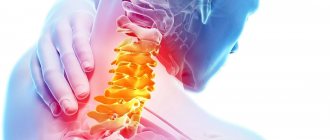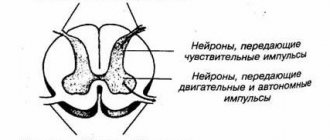Vertebro-basilar insufficiency against the background of cervical osteochondrosis is diagnosed in every third patient. VBI is a reversible disorder of brain function that causes a decrease in blood supply. As a result of a decrease in the supply of molecular oxygen, nutrients, and bioactive substances to neurons, specific symptoms arise that are characteristic only of osteochondrosis of this localization. Patients complain of frequent headaches, dizziness, and surges in blood pressure. There have been cases of dyspeptic disorders, decreased visual acuity and (or) hearing.
The narrowing is visible on angiography.
To diagnose the syndrome, a number of instrumental and laboratory studies are carried out. The most informative are angiography, Doppler ultrasound, and radiography of the cervical spine. In most cases, patients are indicated for conservative treatment of pathology - taking pharmacological medications, performing physiotherapeutic procedures. If severe complications develop, patients are prepared for surgery.
Causes
Osteochondrosis of the cervical spine is a chronic degenerative disease that occurs due to gradual damage to the intervertebral discs and then to the vertebrae. The cause of the destruction of cartilage tissue is a violation of diffuse metabolism, through which vitamins, microelements, and nutrients enter the vertebral structures. Under conditions of the resulting deficiency, destructive changes begin to occur in the cartilage discs. They become damaged, become thinner, and lose their shock-absorbing properties.
The X-ray image shows deformation of the vertebrae.
Then comes the turn of the vertebrae, which are injured under serious static and dynamic loads. With osteochondrosis of 2, 3, 4 degrees of severity, these bone structures shift, and displacement of the intervertebral disc provokes the formation of intervertebral hernias. The vertebrae become unstable, and processes are launched in the body to compensate for this disorder. The edges of the bone plates flatten and grow, forming bone growths - osteophytes. The transverse processes of the vertebrae are equipped with openings in which the vertebral artery is located. A large blood vessel supplies oxygen and nutrients to the following structures:
- spinal segments up to the 2nd thoracic vertebra;
- brain stem;
- inner ear and balance organs;
- cerebellum;
- posterior parts of the hypothalamus, thalamus;
- temporal, occipital lobes of the brain.
This is what osteophytes look like in the photo.
Formed osteophytes, as well as a narrowed intervertebral canal, prevent normal blood supply to these vital structures. The centers of the brain stem regulate breathing, swallowing, and the functioning of the cardiovascular system. No less important are the parts of the central nervous system that are supplied with blood by the vertebral artery. At the initial stage of osteochondrosis, with a lack of oxygen or nutrients, anastomoses, or natural connections of blood vessels, are involved. If one artery partially loses its ability to supply blood, the second begins to pump a larger volume of blood.
As cervical osteochondrosis progresses, the compensatory mechanism no longer works. The volume of blood entering the brain is not enough for its active functioning. Vertebro-basilar insufficiency develops. Doctors have identified additional factors that provoke cerebral ischemia (insufficient oxygen supply due to blockage of blood vessels). These are hematopoietic disorders, increased thrombus formation, cardiogenic embolism, complete occlusion of the lumens of blood vessels as a result of atherosclerotic stenosis.
The mechanism of pathology development
Vertebral (or vertebral) arteries are large paired vessels that rise up the neck to the head. They begin at the base of the neck and pass through openings in the transverse processes of the vertebrae on either side of the spine.
Vertebro-basilar basin: four parts (segments) of the paired vertebral artery and the basilar artery. Click on photo to enlarge.
At the base of the skull, these vessels merge into the large basilar artery, which supplies blood to areas of the brain responsible for functions such as:
Hearing, vision. Sensitivity of certain areas of the body. Orientation in space. Attention, memory, coordination of movements.
Due to their compression, the vessel bed narrows and the amount of blood, and with it nutrients (glucose) and oxygen, decreases.
This leads to disruption of the metabolism and functions of the nervous tissue of the brain. The larger the area that is “starved,” the more symptoms of basilar insufficiency a person experiences.
What can reduce the lumen of a vessel in cervical osteochondrosis? Changes in the structure of the intervertebral disc gradually lead to the fact that its outer part (fibrous membrane) cracks and loses its density.
And the inner part, under the pressure of the vertebral bodies, is gradually “pressed” through the membrane outward (protrusion), and then breaks through it completely (hernia).
Stages of development of a disc herniation: protrusion, formed hernia
In the area of the protrusion, the muscles tense, during an exacerbation, a focus of aseptic inflammation is formed, and swelling appears.
Over time, the edges of the vertebral bodies adjacent to the damaged intervertebral disc become overgrown with bone growths (this is how the body tries to reduce pressure on the intervertebral disc).
All these formations and formations (edema, muscle spasm, bone spines, hernial protrusion, tissue that is squeezed out of the intervertebral disc during protrusion) can compress the artery and reduce the lumen of the vessel.
Displacement of the vertebrae or weakness of the ligaments that hold the vertebrae in place can also cause compression of the artery. This leads to the fact that the holes through which the vessels pass are deformed and change shape, creating an obstacle to normal blood flow.
Compression of the vertebral artery by a displaced vertebra
Clinical picture
VBN syndrome against the background of cervical osteochondrosis is characterized by numerous clinical manifestations. They can be paroxysmal, occurring only during an ischemic attack, and permanent, that is, constantly present. The basin of the arteries of the vertebrobasilar system can be affected by transient ischemic attacks, ischemic strokes, including lacunar strokes. Damage occurs unevenly - during diagnosis, various localizations of pathological foci are discovered. They differ in size, which determines the possibilities of collateral circulation.
Neurological syndrome rarely manifests itself as a whole set of symptoms, since the blood supply system to the brain is quite variable. Most often, during an attack, sensory disorders and (or) motor disorders occur. Specific signs of the clinical picture of vertebrobasilar insufficiency:
- movement disorders - central paresis, impaired coordination of movements. Typically, dynamic ataxia (partial or complete loss of coordination of voluntary muscle movements) is combined with tremors. Gait is disrupted, muscle tone decreases, posture changes;
- sensory disorders. With osteochondrosis of moderate or severe severity, paresthesia, or sensitivity disturbances, appear, which are characterized by spontaneously occurring sensations of burning, tingling, and crawling. In some cases, disorders of superficial or deep sensitivity affect not only the back of the neck, but also the shoulders, forearms, hands, and face;
- visual disturbances. Doctors diagnose patients with various loss of visual fields - scotoma, homonymous hemianopsia, cortical blindness, visual agnosia. Patients complain of the appearance of subjective light sensations in the form of sparks, shine, lightning, fiery surfaces, luminous rings, lines. Vision becomes blurred, objects lose their clear outlines;
- dysfunction of the cranial nerves. Rarely, in severe cases of cervical osteochondrosis, oculomotor disorders develop in the form of diplopia (doubling of the image of a visible object), convergent or divergent strabismus, and differences in the distance of the eyeballs. There have been cases of peripheral paresis of the facial nerve - disruption of the functioning of facial muscles. Bulbar syndrome, or disturbance of speech and swallowing, may also occur due to peripheral paralysis or paresis of the muscles of the tongue, soft palate, pharynx, epiglottis, larynx;
- pharyngeal, laryngeal clinical manifestations. Patients complain to doctors of a “lump in the throat,” pain in the larynx, difficulty swallowing food, and spasms of the esophagus. The voice may become hoarse, and there is a desire to constantly clear your throat in order to eliminate the feeling of a foreign object in the throat.
Almost all patients with vertebrobasilar insufficiency suffer from frequent dizziness. They last from 2-3 minutes to an hour, depending on the sensitivity of the vestibular apparatus. Patients experience a variety of sensations: sinking, motion sickness, unsteadiness of space, rotation of surrounding objects. Dizziness is often accompanied by autonomic disorders. Sweating increases, heart rate changes, digestive disorders occur, and blood pressure rises.
Doctors' recommendations
Timely visit to the clinic will prevent complications of the disease.
For treatment to be most effective, patients should:
- control body weight - obesity is unacceptable;
- stop drinking alcohol and smoking;
- use armchairs and chairs with headrests;
- lead an active lifestyle, take walks in the fresh air;
- reduce physical activity;
- exclude the consumption of fried, smoked, spicy and salty foods;
- stop sleeping on your stomach;
- watch your posture;
- avoid prolonged sitting;
- use special devices to relieve the neck when flying or on long trips;
- seek medical help in a timely manner.
These recommendations can significantly increase the chances of recovery.
https://youtube.com/watch?v=4FYcojnAlsU
Diagnostics
When diagnosing vertebrobasilar insufficiency, certain difficulties arise. This is due to the wide variety of symptoms characteristic of many other pathologies. Each patient subjectively evaluates his experiences and veiledly describes the sensations that arise. Numerous differential studies are often required to identify the syndrome. It is necessary to exclude vestibular neuronitis, acute labyrinthitis, Meniere's disease, acoustic neuroma, demyelinating diseases, normal pressure hydrocephalus, and psychoemotional disorders. To confirm vertebrobasilar insufficiency, patients are prescribed the following instrumental studies:
- Doppler ultrasound to assess the characteristics of blood flow (speed of blood movement, completeness of blood supply to various structures), determine the presence or absence of occlusions;
- angiography with contrast, necessary to visualize the condition of blood vessels, especially their walls;
- radiography, revealing the degree of damage to bone, cartilage tissue, and nearby connective tissue structures;
- tests with hyperventilation, allowing to establish possible disorders in the functioning of the cardiovascular system;
- CT or MRI are performed to identify the stage of the degenerative-dystrophic process in the cervical spine, the presence of formed intervertebral hernias, the degree of compression of blood vessels and spinal roots by bone growths;
- rheoencephalography, which helps assess the blood supply to all parts of the brain;
- MRI angiography, which allows you to accurately examine the main arteries of the head.
For cervical osteochondrosis complicated by vertebrobasilar insufficiency, thrombolytic therapy or other surgical operations are performed. To determine the condition of the vertebral arteries and establish the surgical field, the patient is shown x-ray panangography. The vertebrogenic effect on the vertebral artery is also confirmed by x-ray examination performed with functional tests. Biochemical blood tests are performed to assess general health and identify unidentified chronic metabolic or endocrine pathologies.
Types of diagnostic measures
Diagnosis is carried out to identify the cause of the disease. Post-traumatic vestibulopathy is easily diagnosed, since its development is preceded by some kind of trauma. In all other cases, it is difficult to determine the list of possible factors.
The initial diagnostic stage includes the following:
- taking anamnesis;
- taking tests;
- carrying out standard research.
In the absence of a positive result, the patient is prescribed the following types of examinations:
- neurological;
- MRI of the cervical spine;
- otolaryngological.
Magnetic resonance imaging is necessary to assess the condition of the bones, muscles, joints and nerves of the cervical spine. This study allows you to identify any pathological changes that can cause headaches.
An otolaryngological examination includes a consultation with an otolaryngologist and examination of the eardrum using an otoscope.
Features of neurological examination
Neurological examination methods include:
- ophthalmoscopy;
- Babinski reflex assessment;
- tests to detect dysfunction of the cerebellum;
- test for diadochokinesis;
- knee-heel test.
Ophthalmoscopy is used to assess the condition of the retina, optic nerve head, and fundus vessels.
The absence of the Babinski reflex indicates damage to the nerve fibers responsible for the coordination of movement. Its assessment is carried out by stroking the foot. Normally, the fingers bend during stroking. Damage to the nerve fibers leads to their fan-shaped extension.
Cerebellar function is tested by performing a finger-nose test, where the patient closes his eyes, extends his arm, and then touches the tip of his nose with his index finger.
A test for diadochokinesis involves testing the patient's ability to perform a series of sequential actions, for example, bending and straightening fingers.
We advise you to study - Compression of the dural sac of the spine
Basic treatment methods
In the acute course of vertebrobasilar insufficiency, urgent elimination of all symptoms is required. A sharp rise in blood pressure, hypoxia, and an increase in heart rate are fraught with serious consequences, for example, a stroke. In such cases, patients are hospitalized for therapy in the neurological department. They are advised to take antihypertensive drugs (Corinfar, Enalapril) to eliminate arterial hypotension. Medications to relieve gastrointestinal disorders (Motilak, Cerucal) and reduce the severity of headaches (Spazgan, Maxigan) are necessarily prescribed. After feeling better, the patient is discharged for treatment at home. He is required to wear a Shants collar. The use of this orthopedic device helps to increase the distance between the vertebrae and eliminate compression of the vertebral artery by osteophytes. Vertebrologists include the following drugs in treatment regimens:
- neuroprotectors (Piracetam, Vinpocetine, Thioctic acid) to increase the resistance of brain cells to oxygen starvation;
- drugs to improve blood circulation in the cervical spine and brain - Eufillin, Pentoxifylline, Nicotinic acid;
- muscle relaxants (Baclofen, Baklosan, Sirdalud, Mydocalm) if muscle spasm is detected;
- products with betahistine (Vestibo, Tagista, Betaserc) to eliminate dizziness.
To speed up blood circulation, physiotherapeutic procedures are carried out - laser therapy, magnetic therapy, electrophoresis, UHF therapy. Patients are advised to stop smoking and drinking alcohol. It is necessary to exclude from the diet foods high in salt, fat, and simple carbohydrates.
During remission, the symptoms of osteochondrosis weaken, manifesting as discomfort in the neck after intense physical activity. But in the absence of medical intervention, relapses occur more often and occur with more pronounced clinical manifestations. To avoid surgical intervention (bypass surgery, replantation, angioplasty), it is necessary to contact a vertebrologist at the first signs of vertebrobasilar insufficiency.
Prevention of the development of VBI
A set of preventive measures is aimed at preventing the development of the causes leading to the described pathology. Prevention is necessary not only at the stage when the disease can still be prevented. At the initial stages of the disease, pathological changes can be stopped and progression prevented.
List of necessary preventive measures:
- Dieting. Includes avoidance of fast foods, sausages, smoked meats, fatty and fried foods.
These products should be replaced by including boiled meat, low-fat cottage cheese, fruits, vegetables and berries in the diet;
- Quitting smoking, alcohol;
- Reducing the amount of salt consumed;
- Do not neglect gymnastic exercises;
- Try not to sit in one position for a long time.
In conclusion, I would like to emphasize once again that only an integrated approach to the prevention and treatment of vertebrobasilar insufficiency will bring the desired result and save you from the numerous health problems that this condition provokes.
Based on materials from: yourspinka.ru
What awaits patients suffering from VBI due to osteochondrosis?
Every third patient with a history of intertwined destructive-degenerative changes in the spinal column with this symptom becomes a victim of ischemic stroke. The brain does not receive the required amount of nutrients, which means that a person suffers not only physically, but also from intellectual impairments.
It is not possible to lead a normal lifestyle. Any methods of traditional medicine and self-medication will not help eliminate the symptoms, and certainly will not get rid of the cause of the disease. Treatment with a favorable outcome is only possible under the supervision of competent specialists.
General symptoms
Disorders of the vestibular apparatus, regardless of type, have similar symptoms. The most common symptom occurring in all patients is dizziness. In some patients, it manifests itself by rotating objects in one direction. Others note that objects around them move. Sick people have an impaired sense of balance. The gait becomes unsteady, and in case of serious violations, falls are possible.
Dizziness is accompanied by varying degrees of nausea. Severe nausea causes the urge to vomit.
Another manifestation of the disease is cephalgic syndrome - a condition accompanied by pain in the head area. Headaches manifest differently in different patients. It may be minor or unbearable. For some people it accompanies it all the time, for others it occurs occasionally.
Patients experience visual and auditory disturbances. “Floaters” and spots appear in the eyes, objects lose clarity, and hearing acuity decreases.










